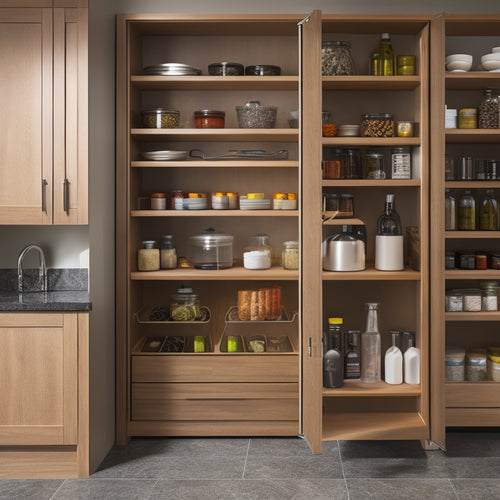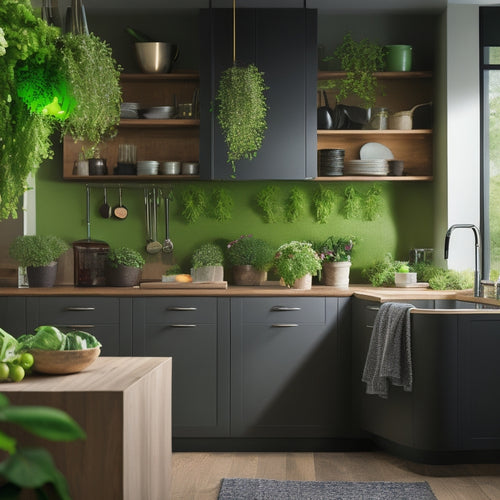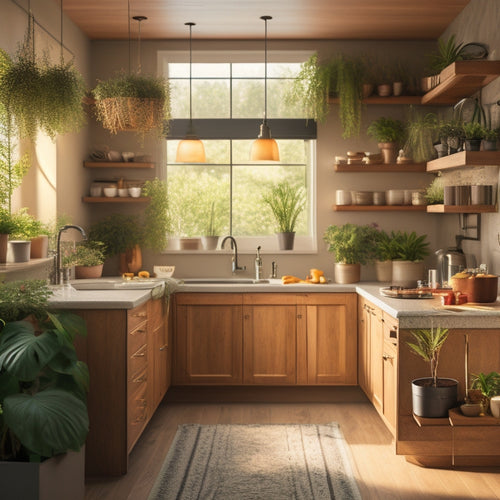
Revolutionize Your Kitchen Organization With DIY Cart
Share
A thoughtfully designed DIY rolling cart can transform a cluttered kitchen into a streamlined workspace by maximizing vertical storage, optimizing layout, and providing endless customization possibilities. By incorporating a DIY cart, homeowners can create a space-saving solution that fits their specific needs and style, all while staying within budget. With the right materials, tools, and design considerations, a DIY cart can lead to a more efficient and organized kitchen. By investing time and effort into building a customized cart, homeowners can reveal the full potential of their kitchen and discover innovative ways to enhance their cooking experience.
Key Takeaways
• A DIY cart maximizes vertical storage, optimizes kitchen layout, and offers endless customization possibilities for a tailored solution.
• Building a DIY cart is cost-effective compared to buying pre-made storage solutions and leads to a more streamlined kitchen.
• Selecting the right materials and tools is crucial for creating an efficient rolling cart that meets specific kitchen storage needs.
• Customizing the cart with shelves, compartments, or baskets optimizes its layout and enhances its functionality.
• Proper maintenance and care, including regular cleaning and wheel lubrication, are essential for maintaining the cart's longevity and performance.
DIY Cart Benefits and Advantages
By incorporating a DIY rolling cart into your kitchen, you can access a multitude of benefits that will revolutionize your cooking space. This includes maximizing vertical storage to enhance overall efficiency and organization. As a space-saving solution, a DIY cart optimizes your kitchen's layout, providing easy access to essential items while keeping countertops clear.
Additionally, customization possibilities are endless, allowing you to tailor the cart to your specific needs and style. This efficiency boost also comes with cost-effective options, saving you money compared to buying pre-made storage solutions. By investing time and effort into building your own cart, you'll reap the rewards of a more streamlined kitchen, perfect for safe and stress-free cooking.
Building Your Rolling Cart Essentials
To bring your DIY rolling cart vision to life, it's essential to gather the right materials and tools, which will form the foundation of a sturdy and functional storage solution that meets your kitchen's unique needs.
When it comes to cart design, consider the size, shape, and style that will best fit your kitchen's layout and aesthetic. Wood selection is also vital, as it will impact the cart's durability and appearance. Choose high-quality wood boards or plywood that can support the weight capacity you need.
Make sure you have the necessary tools, such as a drill, screws, and a measuring tape, to accurately assemble the cart. By selecting the right materials and tools, you'll be well on your way to creating a functional and efficient rolling cart that enhances your kitchen organization.
Assembling and Customizing Options
With the materials and tools in place, the next stage of your DIY rolling cart project involves assembling the frame and customizing it to suit your specific kitchen storage needs. Guarantee a sturdy cart design by following the step-by-step instructions and using the correct screws and drilling techniques.
As you assemble the frame, consider customization techniques such as adding shelves, compartments, or baskets to maximize storage capacity. Think about the items you want to store and how you can optimize the cart's layout to meet those needs.
Creative Cart Customization Ideas
What distinguishes a DIY rolling cart from a generic storage solution is its potential for creative customization, which can be achieved through a variety of innovative and functional design elements.
To add a personal touch, consider incorporating colorful cart accents, such as vibrant paint or decorative trim. Functional storage additions, like baskets, hooks, or a built-in cutting board, can also enhance the cart's utility.
For added convenience, install a towel rack or paper towel holder to keep essentials within easy reach. By incorporating these customization ideas, you can create a rolling cart that not only complements your kitchen decor but also streamlines your workflow and boosts productivity.
With a little creativity, your DIY cart can become a true showstopper in your kitchen.
Cart Maintenance and Care Tips
Proper upkeep and care are indispensable to maintaining the longevity and performance of your DIY rolling cart, especially in the kitchen where it's subjected to daily use and potential spills.
Regular cleaning is essential to prevent dust buildup and preserve the cart's finish. Additionally, wheel maintenance is crucial to ensure smooth rolling and prevent damage to the floor. Check and lubricate the wheels periodically to keep them in good condition.
It's also important to respect the cart's weight capacity to avoid overloading, which can compromise its durability.
Frequently Asked Questions
Can I Use MDF Boards Instead of Plywood for the Cart Frame?
When considering MDF boards as an alternative to plywood for the cart frame, make sure you prioritize durability and aesthetics. While MDF can be a cost-effective option, it may compromise on strength and moisture resistance, affecting the cart's overall stability and longevity.
How Do I Ensure the Cart's Stability on Uneven Kitchen Floors?
In medieval times, a strong foundation was essential for castle fortifications; similarly, a DIY cart's stability on uneven kitchen floors relies on floor levelers, bracing, and non-slip mats or shims to prevent wobbling and guarantee safe operation.
Are There Any Specific Safety Precautions When Assembling the Cart?
When assembling the cart, prioritize safety measures by wearing protective gear, ensuring a stable work surface, and following assembly tips, such as measuring twice and using clamps to prevent accidental collapses or injuries.
Can I Add a Drawer or Cabinet to My DIY Rolling Cart Design?
When considering a drawer attachment or cabinet addition to your DIY rolling cart, guarantee proper structural support and weight distribution to avoid tipping or collapse, and choose hardware suitable for the added weight and functionality.
How Do I Prevent the Cart's Finish From Scratching or Fading Over Time?
To prevent the cart's finish from scratching or fading, apply protective coatings such as polyurethane or varnish, and follow maintenance tips like regular polishing and avoiding harsh chemicals to guarantee a durable and long-lasting finish.
Related Posts
-

Space-Saving Lazy Susan Cabinet Solutions
Space-saving Lazy Susan cabinet solutions can change those awkward corner spaces into organized storage wonders. You'...
-

Rechargeable Under-Cabinet Lighting for Sustainable Kitchens
Rechargeable under-cabinet lighting is ideal for your sustainable kitchen. You'll enjoy energy efficiency with LED te...
-

Space-Saving Kitchen Island Storage Hacks
You can change your small kitchen into a functional haven with clever space-saving island storage hacks. Start by ins...


